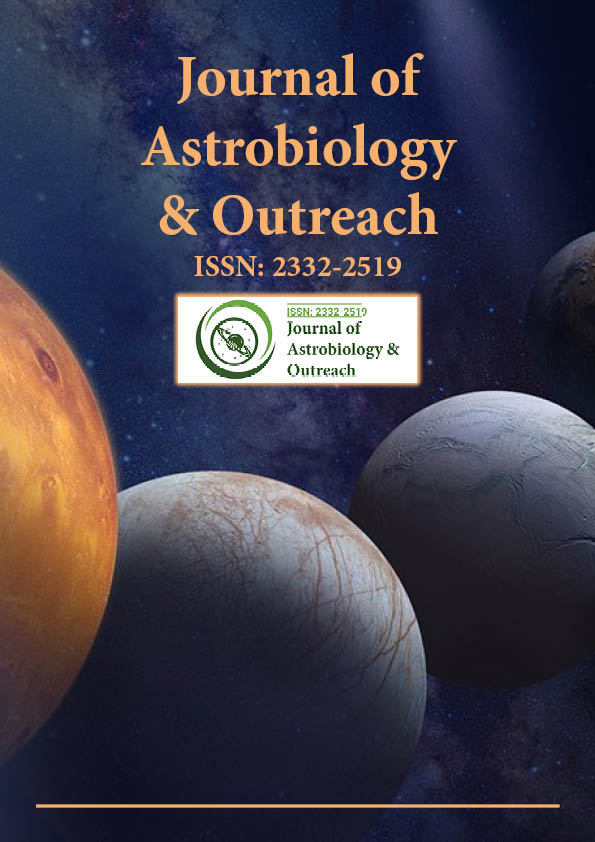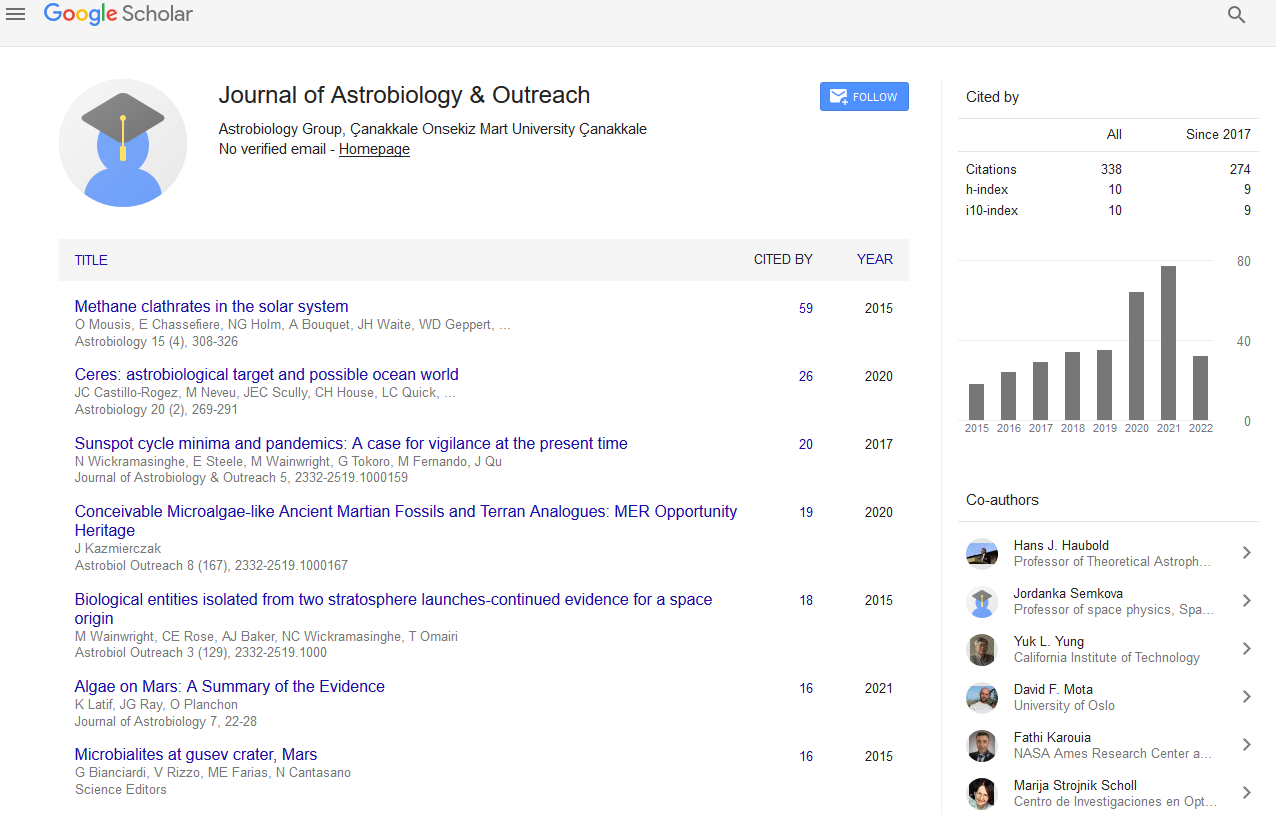Indexed In
- Open J Gate
- Academic Keys
- JournalTOCs
- RefSeek
- Hamdard University
- EBSCO A-Z
- OCLC- WorldCat
- Google Scholar
Useful Links
Share This Page
Journal Flyer

Open Access Journals
- Agri and Aquaculture
- Biochemistry
- Bioinformatics & Systems Biology
- Business & Management
- Chemistry
- Clinical Sciences
- Engineering
- Food & Nutrition
- General Science
- Genetics & Molecular Biology
- Immunology & Microbiology
- Medical Sciences
- Neuroscience & Psychology
- Nursing & Health Care
- Pharmaceutical Sciences
Opinion Article - (2025) Volume 13, Issue 1
Genetic Uniformity and Physiological Adaptation of Zebrafish in Microgravity
Olivia Arcturus*Received: 19-Feb-2025, Manuscript No. JAO-25-28778; Editor assigned: 21-Feb-2025, Pre QC No. JAO-25-28778 (PQ); Reviewed: 07-Mar-2025, QC No. JAO-25-28778; Revised: 14-Mar-2025, Manuscript No. JAO-25-28778 (R); Published: 21-Mar-2025, DOI: 10.35248/2332-2519.25.13.379
Description
The selection of zebrafish for cultivation aboard the world space station represents not just a significant milestone in astrobiology but also a critical intersection of genetic relevance, physiological simplicity and experimental adaptability. As space agencies prepare for long-duration space missions and envision sustainable extraterrestrial habitats, choosing the right biological model becomes a foundational step toward understanding how complex vertebrates adapt to the space environment. The zebrafish (Danio rerio) provides an optimal combination of biological features, making it a compelling candidate for the first vertebrate cultivation experiment in microgravity.
Zebrafish have long been regarded as a strong model organism in developmental biology, genetics and toxicology due to their well-annotated genome, transparent embryos and rapid growth cycle. These characteristics are now being controlled to investigate how vertebrate systems function in space. Their small size and aquatic nature also facilitate the design of controlled habitat systems aboard the space station, reducing the logistical complexity associated with terrestrial vertebrates. Yet, this selection must go beyond the obvious biological and logistical advantages and account for the scientific depth, mission goals and broader implications of space-based experimentation.
An ideal zebrafish selection strategy must prioritize genetic uniformity and experimental reproducibility while accommodating the diversity of physiological traits necessary to answer core space biology questions. Strains chosen should exhibit reliable breeding behavior under artificial conditions and possess known phenotypes related to musculoskeletal development, neural regulation and immune response. For example, transgenic lines expressing fluorescent markers under specific promoters enable real-time, in vivo tracking of biological processes such as bone remodeling, tissue regeneration and cardiovascular adaptation under microgravity.
Another fundamental consideration is the developmental stage at which zebrafish are sent into space. Embryonic zebrafish, particularly during the early segmentation and organogenesis phases, are especially sensitive to environmental changes, making them ideal for studying how spaceflight affects vertebrate development at the cellular and molecular levels. However, adult zebrafish are better suited for behavioral, reproductive and endocrine studies and can provide insight into the long-term effects of space exposure, including fertility and generational adaptation. A balanced experimental design might involve co-cultivation of embryos and adults, allowing researchers to trace the effects of space conditions across life stages.
Environmental control within the aquatic housing systems will be essential to the success of the experiment. Temperature, water quality, oxygenation and feeding schedules must be rigorously managed through autonomous systems or astronaut assistance. Zebrafish are particularly susceptible to environmental stressors, which can confound experimental outcomes if not carefully mitigated. Therefore, pre-flight simulations in ground-based analogs and parabolic flights will be instrumental in validating the resilience of selected strains and optimizing system parameters.
The implications of zebrafish space cultivation go beyond the immediate biological data. As vertebrates that share significant genetic homology with humans, the insights derived from zebrafish experiments can inform medical research related to microgravity-induced bone loss, muscle atrophy and immune dysfunction in astronauts. Furthermore, data from zebrafish could help refine pharmacological strategies by evaluating drug metabolism and efficacy in altered physiological states. These applications demonstrate the translational value of such experiments for both space and terrestrial medicine.
Critics may argue that using vertebrate models in space carries ethical, logistical and financial burdens. While these concerns are valid, the benefits of such research, if conducted under rigorous ethical and scientific standards, far outweigh the drawbacks. The knowledge gained from these pioneering experiments will shape future protocols, habitat designs and health support systems essential for the sustainability of human presence in space.
In conclusion, the strategic selection of zebrafish for cultivation aboard the world space station is a forward-looking decision that aligns with both scientific necessity and practical feasibility. It provides an opportunity to unlock new biological insights while setting the stage for more experienced life sciences research in orbit. A carefully curated selection strategy including genetic considerations, life stage, environmental control and translational potential will ensure the success of this landmark experiment and mark a significant step toward the future of integrative space biology.
Citation: Arcturus O (2025). Genetic Uniformity and Physiological Adaptation of Zebrafish in Microgravity. J Astrobiol Outreach. 13:379.
Copyright: © 2025 Arcturus O. This is an open-access article distributed under the terms of the Creative Commons Attribution License, which permits unrestricted use, distribution, and reproduction in any medium, provided the original author and source are credited.

